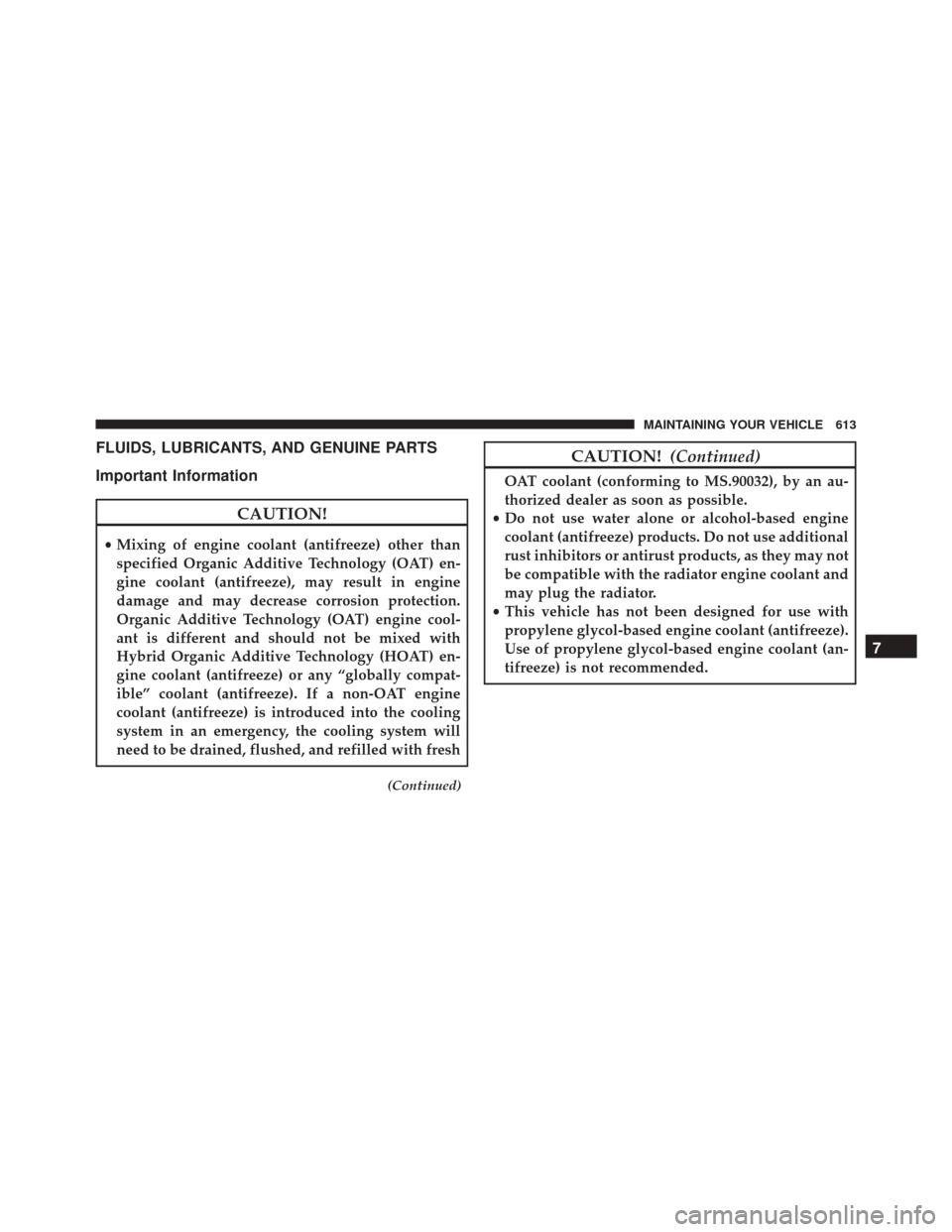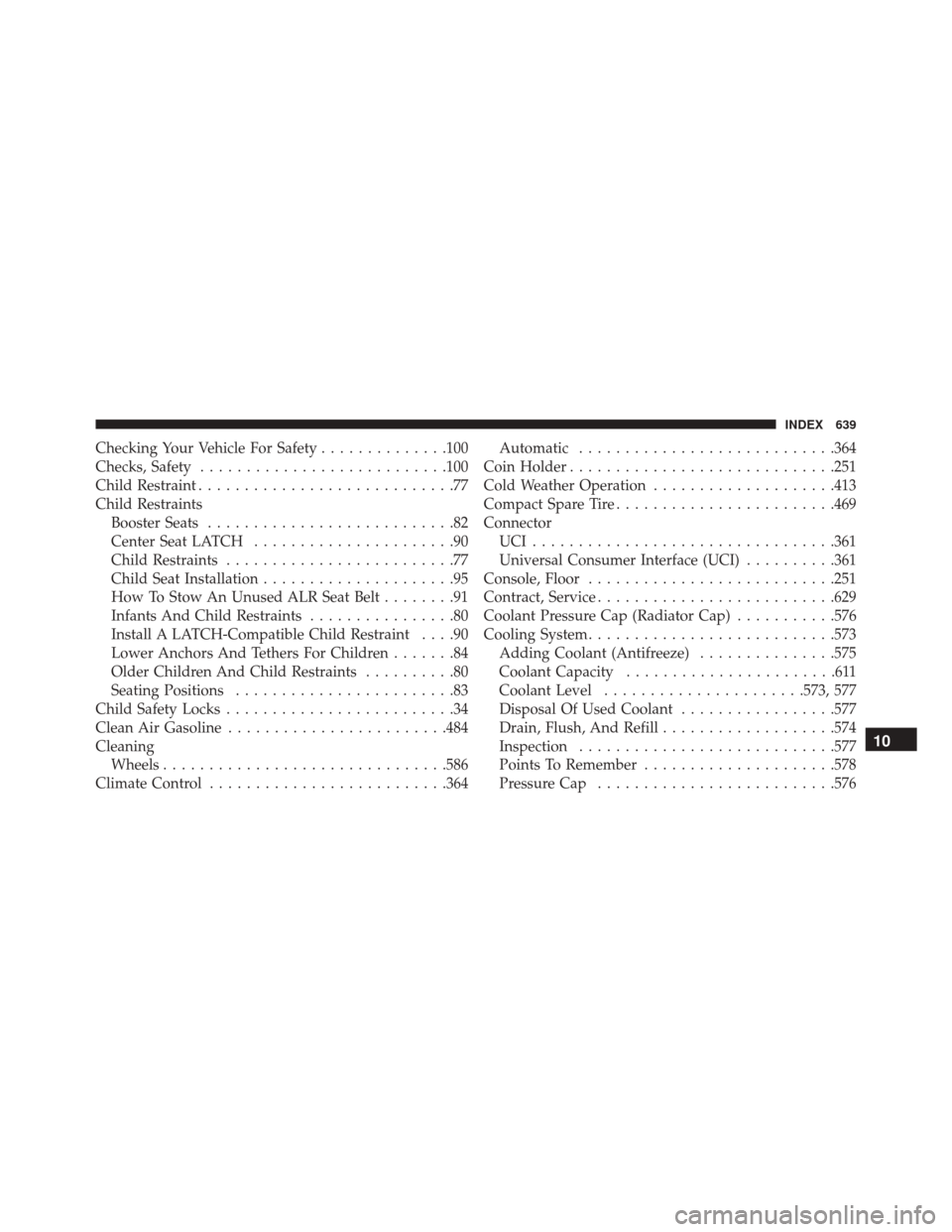Page 580 of 661

When additional engine coolant (antifreeze) is needed to
maintain the proper level, only OAT coolant that meets
the requirements of FCA Material Standard MS.90032
should be added to the coolant bottle. Do not overfill.
Points To Remember
NOTE:When the vehicle is stopped after a few miles/
kilometers of operation, you may observe vapor coming
from the front of the engine compartment. This is nor-
mally a result of moisture from rain, snow, or high
humidity accumulating on the radiator and being vapor-
ized when the thermostat opens, allowing hot engine
coolant (antifreeze) to enter the radiator.
If an examination of your engine compartment shows no
evidence of radiator or hose leaks, the vehicle may be
safely driven. The vapor will soon dissipate.
• Do not overfill the coolant expansion bottle. •
Check the coolant freeze point in the radiator and in
the coolant expansion bottle. If engine coolant (anti-
freeze) needs to be added, the contents of the coolant
expansion bottle must also be protected against freez-
ing.
• If frequent engine coolant (antifreeze) additions are
required, the cooling system should be pressure tested
for leaks.
• Maintain engine coolant (antifreeze) concentration at a
minimum of 50% OAT coolant (conforming to
MS.90032) and distilled water for proper corrosion
protection of your engine which contains aluminum
components.
• Make sure that the coolant expansion bottle overflow
hoses are not kinked or obstructed.
• Keep the front of the radiator clean. If your vehicle is
equipped with air conditioning, keep the front of the
condenser clean.
578 MAINTAINING YOUR VEHICLE
Page 596 of 661
CavityCartridge Fuse Mini-Fuse Description
19 50 Amp Red –Electric Power Steering #2 –
If Equipped / Radiator Fan (6.2L Supercharged)
20 30 Amp Pink –Wiper Motor
21 30 Amp Pink
20 Amp Blue – Police –
Headlamp Washers – If Equipped
Police Bat Feed #2
22 40 Amp Green /
20 Amp Blue – Police –
Engine Cooling Pump
(6.2L Supercharged) / Police Bat Feed # 3
23 20 Amp Blue –Police Bat Feed # 1
24 20 Amp Blue –Police Ignition Run/ACC Feed # 3
28 –– Fuse – Spare
29 –15 Amp Blue Transmission Control Module
(Challenger/Charger Police) /
Electronic Shift Module (Challenger)
594 MAINTAINING YOUR VEHICLE
Page 613 of 661
FLUID CAPACITIES
Fluid Capacities — 3.6L
U.S.Metric
Fuel (Approximate)
87 Octane, 0-15% Ethanol or up to 85% Ethanol for Flex Fuel
(E-85) Engine 18.5 Gallons
69.9 Liters
Engine Oil With Filter
SAE 5W-20, API Certified 6 Quarts5.6 Liters
Cooling System*
MOPAR Antifreeze/Engine Coolant 10 Year/150,000 Mile Formula
or equivalent 10 Quarts
9.5 Liters
* Includes heater and coolant recovery bottle filled to MAX level.
7
MAINTAINING YOUR VEHICLE 611
Page 614 of 661
Fluid Capacities — 5.7L
U.S.Metric
Fuel (Approximate)
89 Octane Recommended – 87 Octane Acceptable, 0-15% Ethanol 18.5 Gallons 69.9 Liters
Engine Oil With Filter
SAE 5W-20, API Certified 7 Quarts6.6 Liters
Cooling System*
MOPAR Antifreeze/Engine Coolant 10 Year/150,000 Mile Formula
or equivalent – without Severe Duty II Cooling System 14.5 Quarts
13.9 Liters
MOPAR Antifreeze/Engine Coolant 10 Year/150,000 Mile Formula
or equivalent – with Severe Duty II Cooling System 15 Quarts
14.3 Liters
* Includes heater and coolant recovery bottle filled to MAX level.
612 MAINTAINING YOUR VEHICLE
Page 615 of 661

FLUIDS, LUBRICANTS, AND GENUINE PARTS
Important Information
CAUTION!
•Mixing of engine coolant (antifreeze) other than
specified Organic Additive Technology (OAT) en-
gine coolant (antifreeze), may result in engine
damage and may decrease corrosion protection.
Organic Additive Technology (OAT) engine cool-
ant is different and should not be mixed with
Hybrid Organic Additive Technology (HOAT) en-
gine coolant (antifreeze) or any “globally compat-
ible” coolant (antifreeze). If a non-OAT engine
coolant (antifreeze) is introduced into the cooling
system in an emergency, the cooling system will
need to be drained, flushed, and refilled with fresh
(Continued)
CAUTION! (Continued)
OAT coolant (conforming to MS.90032), by an au-
thorized dealer as soon as possible.
• Do not use water alone or alcohol-based engine
coolant (antifreeze) products. Do not use additional
rust inhibitors or antirust products, as they may not
be compatible with the radiator engine coolant and
may plug the radiator.
• This vehicle has not been designed for use with
propylene glycol-based engine coolant (antifreeze).
Use of propylene glycol-based engine coolant (an-
tifreeze) is not recommended.
7
MAINTAINING YOUR VEHICLE 613
Page 621 of 661

Severe Duty All Models
Change Engine Oil at 4,000 miles (6,500 km) if the vehicle
is operated in a dusty and off road environment or is
operated predominantly at idle or only very low engine
RPM’s. This type of vehicle use is considered Severe
Duty.
Once A Month Or Before A Long Trip:
•Check engine oil level.
• Check windshield washer fluid level.
• Check tire pressure and look for unusual wear or
damage. Rotate tires at the first sign of irregular wear,
even if it occurs before your next scheduled service.
• Check the fluid levels of the coolant reservoir, brake
master cylinder, and power steering (if equipped) and
fill as needed.
• Check function of all interior and exterior lights. Required Maintenance Intervals:
Refer to the maintenance schedules on the following
page for the required maintenance intervals.
At Every Oil Change Interval As Indicated By Oil
Change Indicator System:
•Change oil and filter
• Rotate the tires.
Rotate at the first sign of irregular
wear, even if it occurs before your next scheduled
service
• Inspect battery and clean and tighten terminals as
required
• Inspect brake pads, shoes, rotors, drums, hoses
and park brake
•
Inspect engine cooling system protection and hoses
• Inspect exhaust system
• Inspect engine air cleaner if using in dusty or
off-road conditions 8
MAINTENANCE SCHEDULES 619
Page 641 of 661

Checking Your Vehicle For Safety..............100
Checks, Safety .......................... .100
Child Restraint ............................77
Child Restraints Booster Seats ...........................82
Center Seat LATCH ......................90
Child Restraints .........................77
Child Seat Installation .....................95
How To Stow An Unused ALR Seat Belt ........91
Infants And Child Restraints ................80
Install A LATCH-Compatible Child Restraint ....90
Lower Anchors And Tethers For Children .......84
Older Children And Child Restraints ..........80
Seating Positions ........................83
Child Safety Locks .........................34
Clean Air Gasoline ....................... .484
Cleaning Wheels .............................. .586
Climate Control ......................... .364Automatic
........................... .364
Coin Holder ............................ .251
Cold Weather Operation ....................413
Compact Spare Tire ....................... .469
Connector UCI................................ .361
Universal Consumer Interface (UCI) ..........361
Console, Floor .......................... .251
Contract, Service ......................... .629
Coolant Pressure Cap (Radiator Cap) ...........576
Cooling System .......................... .573
Adding Coolant (Antifreeze) ...............575
Coolant Capacity .......................611
Coolant Level ..................... .573, 577
Disposal Of Used Coolant .................577
Drain, Flush, And Refill ...................574
Inspection ........................... .577
Points To Remember .....................578
Pressure Cap ......................... .576
10
INDEX 639
Page 643 of 661

DrivingThrough Flowing, Rising, Or Shallow Standing
Water ............................... .430
E-85 Fuel .............................. .488
Electrical Power Outlets .....................245
Electric Rear Window Defrost .................254
Electric Remote Mirrors .....................121
Electronic Brake Control System ...............437
Anti-Lock Brake System ..................438
Electronic Roll Mitigation .................449
Traction Control System ...................444
Electronic Power Distribution Center (Fuses) ......591
Electronic Speed Control (Cruise Control). .176, 177, 180
Electronic Stability Control (ESC) ..............444
Electronic Throttle Control Warning Light ........275
Emergency Deck Lid Release ..................47
Emergency, In Case Of Freeing Vehicle When Stuck ................539 Jacking
.............................. .516
Jump Starting ..................... .535, 537
Overheating .......................... .513
Towing ............................. .544
Emergency Trunk Release ....................47
Emission Control System Maintenance ..........555
Engine ................................ .553
Air Cleaner .......................... .563
Block Heater ......................... .414
Break-In Recommendations .................99
Checking Oil Level ..................... .559
Compartment ...................... .552, 553
Compartment Identification ................552
Coolant (Antifreeze) ...........573, 613, 614, 615
Cooling ............................. .573
Exhaust Gas Caution .................100, 488
Fails To Start ......................... .413
Flooded, Starting ...................... .413
Fuel Requirements ..................... .483
10
INDEX 641